
Author James Duff
Introduction
In the final months of and in the years after World War Two, many resources, documents and records relating to Royal Navy camouflage were purposely destroyed. That there might have been future value in these resources was either not recognized or deemed unimportant. In the decades in between then and now, several researchers have attempted to piece together from old samples, eye witness accounts and photographic records, a view on what the Royal Navy’s colour palette was during the years 1939 to 1945. The author’s motivation for writing this work stems from trying to reconcile contradictions in extant references and various anachronisms evident both in other published works and common belief as compared to formal documentation.
This work deals with the shades M.S.1, M.S.2, M.S.3, M.S.4, M.S.4A and B6 known (along with B5 addressed in a previous paper) as the “Standard Camouflage Colours” by the Royal Navy.
All colour measurements made in the preparation of this paper were carried out using a Nix Pro Color Sensor; a hand held digital device with its own calibrated light source and which is operated using a smart phone application. This made it possible to take digital readings of extant samples in controlled environments where it was not possible to bring the samples to desk-top spectrophotometers. The author’s Nix sensor has been checked against published standard colours as well as spot checked against Sovereign Hobbies Colourcoats factory’s desk mounted spectrophotometer.
The authors trust that the methods, discussion and references made herein will be found to be a robust argument by the reader, and that the reader will have a clearer understanding of the applicable timescales and relative appearances of these shades.
The author would like to extend thanks to the staff of The National Archives at Kew in London, along with Heather Johnson, Curator (Archives) of the National Museum of the Royal Navy, Portsmouth, and also a special thanks to Richard Dennis, Sean Carroll, Michael Brown and Lindsay Johnston who provided a wealth of documentation directly relevant to this paper. This research would not have been possible without the accommodation and willingness of all these sources of primary source references.
Origins
Despite much searching, the author has been unable to determine the exact origins of the Standard Camouflage Colours, which includes the formulations, date(s) of formal introduction and even what the initials ‘M.S.’ actually stood for. It is possible to speculate some possible meanings, but as no documented proof has been discovered, that has no place here.
What is known however is that fragmented letters survive in archives between the Admiralty’s Director of Training and Staff Duties (D.T.S.D.) and the International Paint company* discussing a series of supplied sample paints, at the time named “special camouflage paints” during July 1941 thus:
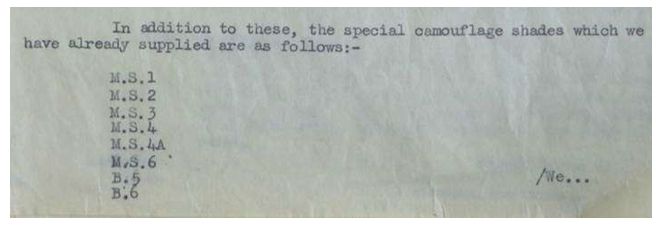
Note here that an eighth shade known as M.S.6 exists at this point in time.
The appraisal and selection process for these colours is unknown. What is known is that D.T.S.D. settled on seven of these shades and entitled the collection the “Standard Camouflage Colours”.
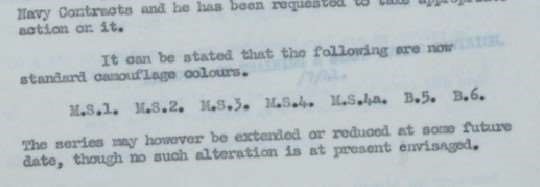
Exactly when these shades came in to wide-spread use is unclear, but the author considers it unlikely that extensive use would have been made of these prior to or during the D.T.S.D.’s selection process in summer 1941, but that by April 1942 these colours were actively promoted within C.A.F.O.679/42 SEA GOING CAMOUFLAGE DESIGNS FOR DESTROYERS AND SMALL SHIPS.
*founded in Gateshead, England by two German brothers in the late 19th century, but had relocated its headquarters to London in the early 20th century
Extant evidence
A number of documents exist which reveal some instructive facts concerning the Standard Camouflage Colours. These include RE/CAM/30/1/1 which lists the Light Reflectance Values of each of the colours, immediately giving the author and reader alike a graduated list of tones from dark to light:

For the convenience, the list from dark to light of the 1942 Royal Navy camouflage colour palette (excluding Mountbatten pink, Western Approaches Blue and Western Approaches Green) was:
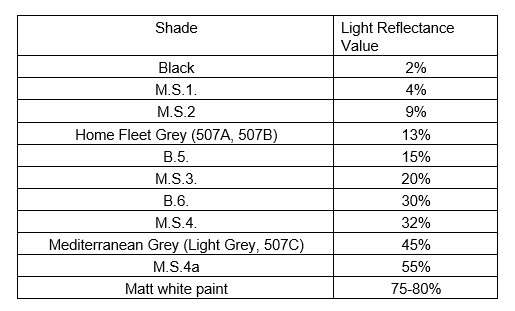
Furthermore, a complete set of surviving physical samples exists in file ADM212/124 at the National Archives at Kew, London, whilst the National Museum of the Royal Navy, accessible via appointment at Portsmouth hold a partial set of samples. The author has visited and recorded both sets.
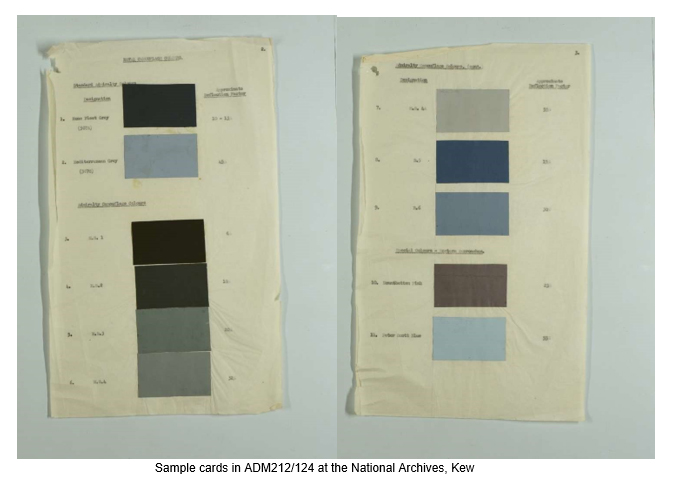
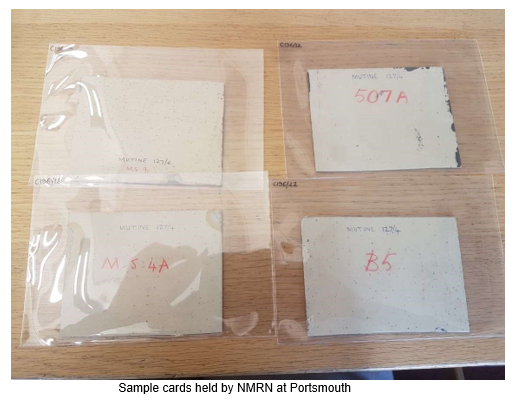
As well as the physical samples in both locations, the National Archives holds a copy of Confidential
Admiralty Fleet Order (C.A.F.O.) 679/42 SEA GOING CAMOUFLAGE DESIGNS FOR DESTROYERS AND SMALL SHIPS. This document was, as the title suggests, distributed to a limited audience and was written for the purposes of explaining camouflage principles and furnish a selection of Admiralty approved set of standard camouflage design patterns to the Commanding Officers of small ships. As well as providing the colour illustrations, this document provided large printed approximations of each shade.
Section 11 of this document states:
COLOURS
- Specimens of colours are shown in C.A.F.O. Diagram 31/42 (1) to (10). An exact match of colour is not essential, but an attempt should be made to preserve the same relative tones (i.e., lightness or darkness of colour) which the plates show ; advice if required should be sought from the Admiralty (D.T.S.D.).
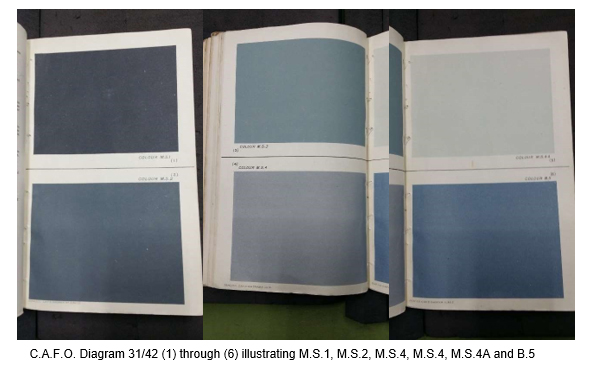
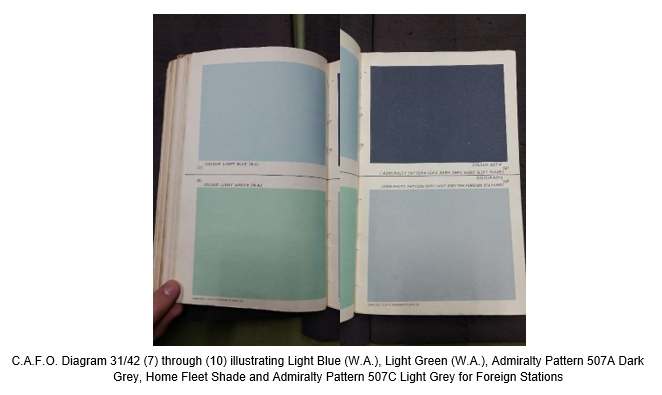
Grey, Home Fleet Shade and Admiralty Pattern 507C Light Grey for Foreign Stations
The C.A.F.O. 679/42 document acknowledges the existence of the colour B.6 insomuch as it states the appropriate colours to use for pendant numbers on a B.6 background, however the reader will note that a diagram of B.6 is not contained. Indeed B.6 features on none of the 51 standard design plates for destroyers and small ships which follow in the document, suggesting that B.6 tended to be used only on larger vessels. An example of the design plates is given thus:

C.A.F.O. Diagram 31/42 (29) illustrating “Town” destroyer, converted; 2 funnels in Dark Admiralty Type pattern
Comparison of evidence
Whilst Section 11 of C.A.F.O. 679/42 may persuade some to abandon any efforts to understand the typical shades used, the author considers it worthwhile to compare what is available to us and thus equip the reader with a balanced view.
An indirect piece of evidence survives in the form of Domestic File AD.29 held at the National Archives at Kew, London, which contains colour measurements taken whilst the Royal Navy was actively working towards rationalising the colour palette and simplifying the naming system. AD.29 contains the findings of the Paint Research Station (P.R.S.) at Teddington. The file is dated 15th October 1942. Exactly where AD.29 fits in is not certain either in terms of what the sampled paints actually were or in terms of what was actually promulgated five months later in AFO2106/43, as the document is tabulated using the incoming nomenclature G5, G10, B15, etc and how these numbers replace the previous designations (M.S.1,2,3 etc) but refers to three distinct sets of paint samples provided by the Admiralty for testing. The wording does strongly suggest that the samples were the nine standard camouflage colours (if we include what was 507A and 507C).
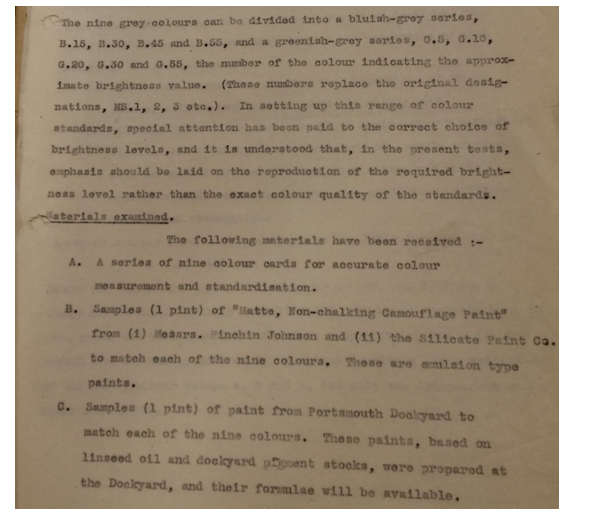
AD.29 Standardisation of Admiralty Camouflage Colours dated 15th October 1942
Whilst the author does not claim to be certain that PRS’ colour measurements recorded in AD.29 are in fact of samples selected by the Admiralty from the Standard Camouflage Paints, the colours recorded do correlate well with the characters of the surviving physical samples. As such it seems likely that PRS’ data is that of fresh samples of most (but not all) of the MS and B series. As the formulations of the MS and B Standard Camouflage Paints are not known, only educated assumptions can be made regarding which photochemical processes may be at work in surviving samples to affect their appearance now. A set of renders of the compiled data is presented as follows, graduated as intended by the Admiralty, from darkest to lightest.
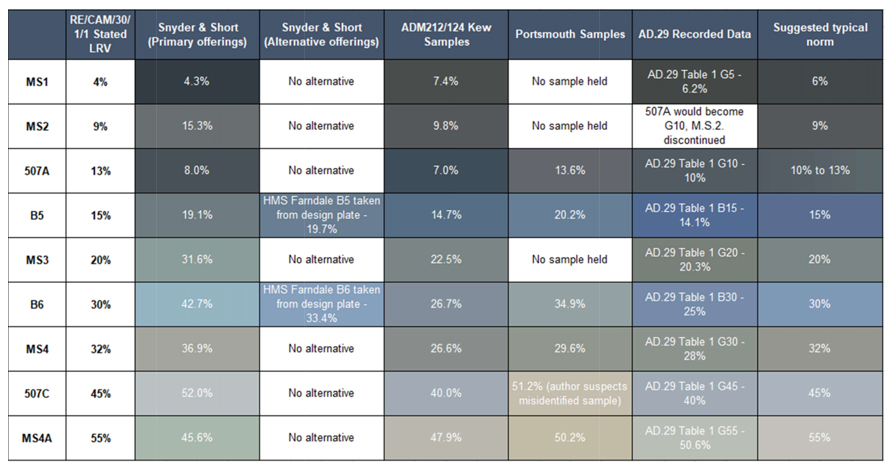
Conclusions
Whilst the exact origins and formulations of the Standard Camouflage Colours (sometimes known in modern times as the MS & B paints) are unknown, and whilst C.A.F.O. 679/42 implies that some tolerance could be expected in the exact hue of the applied paint in service, it is clear that each of the Standard Camouflage Colours had a specified position within the overall tonal range from dark to light and that adherence to the intended tone was encouraged in order that the camouflage pattern be effective.
As such, the author has interpreted and interpolated the available data and surviving samples in the UK to suggest nominal shades which achieve the intended tones whilst capturing the character of each of shades.
The author hopes that the reader, with a fuller understanding of the surviving evidence available for public viewing and the compilation herein will be better able to recognise the either the Standard Camouflage Colours directly – for example that the 14” barrels on HMS King George V here in 1942 are wearing M.S.4 on the “vertical” surfaces with counter shading above and below, or indeed recognise that 507A and M.S.2 will be virtually impossible to distinguish in black and white photographs, as will M.S.4 and B.6. Perhaps more helpfully though, there is a distinction in tone between lighter shades M.S.4, 507C and M.S.4A which may assist interested readers in their interpretation of camouflage colour schemes.
References
In compiling this work, the authors have specifically referenced the following resources, and encourage the reader to review these sources for themselves:
- (October 1942). ADM212/124 Standardisation of Admiralty camouflage colours. [File] The National Archives, Kew, London
- AFO 2106/43 External and Camouflage Painting (HM Ships) – Available to download from the Australian archives http://www.navy.gov.au/media-room/publications/admiralty-fleetorders/1943
We have consulted every paint and camouflage-relevant file, AFO and CAFO we have been able to find or access in UK and Australian archives amongst which the following proved directly relevant to the Standard Camouflage Colours although many others helped shape our thinking:
- A.F.O.679 SEA-GOING CAMOUFLAGE DESIGNS FOR DESTROYERS AND SMALL SHIPS – 9th
April 1942 – Available at The National Archives, Kew, London
- ADM 212/124 Standardisation of Admiralty camouflage colours – (including AD.29 dated 15th October 1942) – Available at The National Archives, Kew, London
- AFO 2106/43 External and Camouflage Painting (HM Ships) – Available to download from the Australian archives http://www.navy.gov.au/media-room/publications/admiralty-fleetorders/1943
- CB3098R/43 THE CAMOUFLAGE OF SHIPS AT SEA – May 1943 – republished by White Ensign Models using Snyder & Short paint chips (Print 2) (Prints 1 and 2 appear to have used different colours)
- AFO 3113/44 External and Camouflage Painting (HM Ships) – – Available to download from the Australian archives http://www.navy.gov.au/media-room/publications/admiralty-fleetorders/1943
- AFO 3545/45- External and Camouflage painting of HM Ships and Vessels – Available at The National Archives, Kew, London




